Contents
| |||||
| Decades: | |||||
|---|---|---|---|---|---|
| See also: | Other events of 1710 List of years in Spain | ||||
This article needs additional citations for verification .(February 2024) |

| |||||
| Decades: | |||||
|---|---|---|---|---|---|
| See also: | Other events of 1710 List of years in Spain | ||||
This article needs additional citations for verification .(February 2024) |

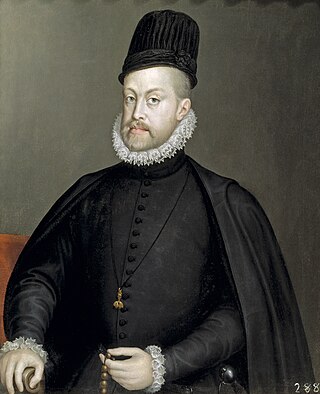
Philip II, sometimes known in Spain as Philip the Prudent, was King of Spain from 1556, King of Portugal from 1580, and King of Naples and Sicily from 1554 until his death in 1598. He was also jure uxoris King of England and Ireland from his marriage to Queen Mary I in 1554 until her death in 1558. Further, he was Duke of Milan from 1540. From 1555, he was Lord of the Seventeen Provinces of the Netherlands.
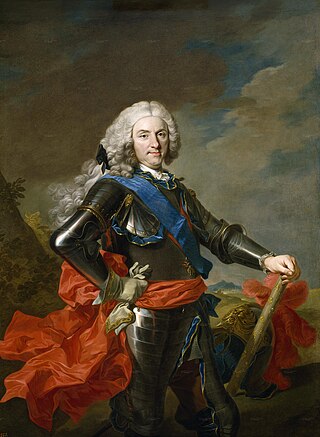
Philip V was King of Spain from 1 November 1700 to 14 January 1724 and again from 6 September 1724 to his death in 1746. His total reign is the longest in the history of the Spanish monarchy, surpassing Philip IV. Although his ascent to the throne precipitated the War of the Spanish Succession, Philip V instigated many important reforms in Spain, most especially the centralization of power of the monarchy and the suppression of regional privileges, via the Nueva Planta decrees, and restructuring of the administration of the Spanish Empire on the Iberian Peninsula and its overseas regions.

Charles V was Holy Roman Emperor and Archduke of Austria from 1519 to 1556, King of Spain from 1516 to 1556, and Lord of the Netherlands as titular Duke of Burgundy from 1506 to 1555. He was heir to and then head of the rising House of Habsburg. His dominions in Europe included the Holy Roman Empire, extending from Germany to northern Italy with rule over the Austrian hereditary lands and Burgundian Low Countries, and Spain with its possessions of the southern Italian kingdoms of Naples, Sicily and Sardinia. In the Americas, he oversaw the continuation of Spanish colonization and a short-lived German colonization. The personal union of the European and American territories he ruled was the first collection of realms labelled "the empire on which the sun never sets".

Fernando Álvarez de Toledo y Pimentel, 3rd Duke of Alba, known as the Grand Duke of Alba in Spain and Portugal and as the Iron Duke or shortly 'Alva' in the Netherlands, was a Spanish nobleman, general and statesman.
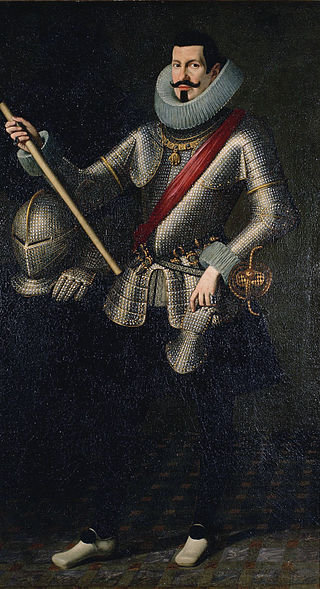
Pedro Téllez-Girón, 3rd Duke of Osuna was a Spanish nobleman and politician. He was the 2nd Marquis of Peñafiel, 7th Count of Ureña, Spanish Viceroy of Sicily (1611–1616), Viceroy of Naples (1616–1620), a Knight of the Order of the Golden Fleece since 1608, Grandee of Spain, member of the Spanish Supreme Council of War, and the subject of several poems by his friend, counselor and assistant, Francisco de Quevedo.
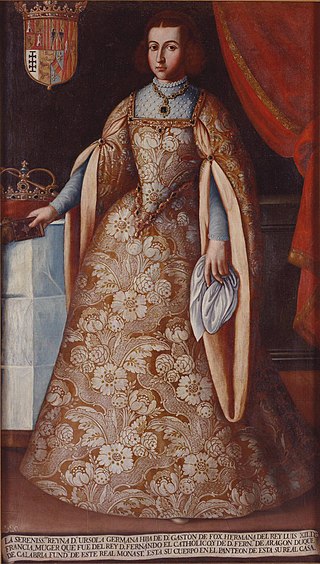
Ursula Germaine of Foix was an early modern French noblewoman from the House of Foix. She was the daughter of John, Viscount of Narbonne, and Marie of Orléans and granddaughter of Queen Eleanor of Navarre. By marriage to King Ferdinand II of Aragon, she was Queen of Aragon, Majorca, Naples, Sardinia, Sicily, and Valencia and Princess of Catalonia from 1505 to 1516 and Queen of Navarre from 1512 to 1516. She was Vicereine of Valencia from 1523 until her death in 1536, jointly with her second and third husbands, respectively Johann of Brandenburg-Ansbach and Ferdinand, Duke of Calabria. By her third marriage, she was Duchess of Calabria.
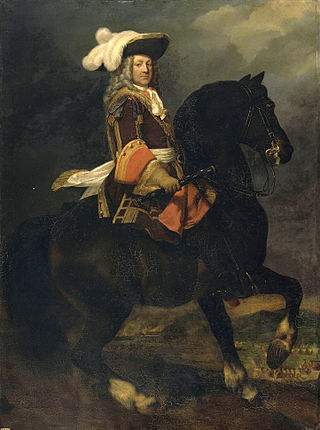
The Battle of Brihuega took place on 8 December 1710 in the War of the Spanish Succession, during the Allied retreat from Madrid to Barcelona. A British Army rearguard led by James Stanhope, 1st Earl Stanhope was cut off and trapped within the town of Brihuega before being overwhelmed by a Franco-Spanish army under the command of Louis Joseph, Duke of Vendôme. The battle, along with other events, brought an end to British participation in the war.
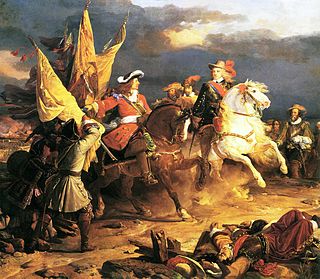
The Battle of Villaviciosa was a battle between a Franco-Spanish army led by Louis Joseph, Duke of Vendôme and Philip V of Spain and a Habsburg-allied army commanded by Austrian Guido Starhemberg. The battle took place during the War of the Spanish Succession, one day after a Franco-Spanish victory at Brihuega against a British army under James Stanhope, 1st Earl Stanhope. Both Philip V of Spain and the Archduke Charles of Austria claimed victory, but the number of dead and wounded, the number of artillery and other weapons abandoned by the Allied army and the battle's strategic consequences for the war confirmed victory for Philip.

The Battle of Saragossa, also known as the Battle of Zaragoza, took place on 20 August 1710 during the War of the Spanish Succession. A Spanish Bourbon army loyal to Philip V of Spain and commanded by the Marquis de Bay was defeated by a Grand Alliance force under Guido Starhemberg. Despite this victory, which allowed Philip's rival Archduke Charles to enter the Spanish capital of Madrid, the allies were unable to consolidate their gains. Forced to retreat, they suffered successive defeats at Brihuega in November and Villaviciosa in December, which effectively ended their chances of installing Archduke Charles on the Spanish throne.

Duke of Osuna is a Spanish noble title that was first awarded in 1562 by King Philip II of Spain to Pedro Girón de la Cueva,. Pedro was also Viceroy of Naples, (1582–1586), Ambassador in Portugal and 5th Count of Ureña.

Pedro Nuño Colón de Portugal y Castro, 6th Duke of Veragua, 6th Marquess of Jamaica, 6th Count of Gelves was viceroy of New Spain from December 3, 1673, to December 8, 1673.

Don Carlos María Alfonso Marcelo de Borbón-Dos Sicilias y Borbón-Parma, Infante of Spain, Duke of Calabria was, at his death, the last male infante of Spain during the reigns of his cousins King Juan Carlos I and King Felipe VI.

Infante Alfonso of Spain, Prince of the Two Sicilies, Duke of Calabria was one of two claimants to the title of the head of the House of Bourbon-Two Sicilies from 1960 until his death in 1964. Alfonso was the son of Prince Carlos of Bourbon-Two Sicilies (1870–1949) and his wife, María de las Mercedes, Princess of Asturias (1880–1904). He was born and died in Madrid, Spain.
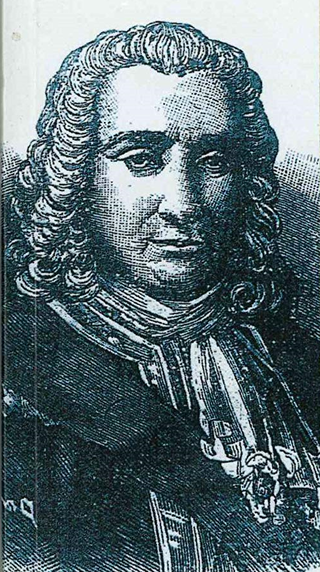
D. António Luís de Sousa, 2nd Marquis of Minas and 4th Count of Prado was a Portuguese general and colonial administrator, Governor-General of Brazil from 1684 to 1687.

Juan Manuel Fernández Pacheco y Zúñiga, Duke of Escalona and Marquess of Villena, was a Spanish aristocrat, politician, and academician who founded the Royal Spanish Academy.

The Battle of Blaye of 1593, also known as the Battle of Bec d'Ambès or Battle of the Gironde Estuary, was a naval Spanish victory that took place on 18 April 1593 off Blaye and Bec d'Ambès, Gironde Estuary, France, during the seven-month siege of Blaye between the French-Protestant forces of Henry of Navarre and the French-Catholic garrison of the city led by Governor Jean-Paul d'Esparbès de Lussan d'Aubeterre, in the context of the Brittany Campaign during the French Wars of Religion and the Anglo-Spanish War (1585–1604).
Pedro Manuel Colón de Portugal y de la Cueva, 7th Duke of Veragua, was a Spanish noble.
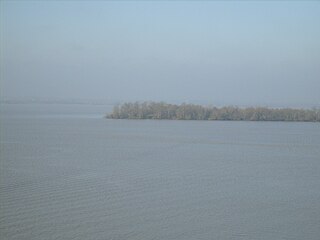
The Battle of Bordeaux was a naval engagement of the Franco-Spanish War of 1635–1659 fought on 20 October 1653 in the Gironde estuary. A Spanish fleet under Álvaro de Bazán, 3rd Marquis of Santa Cruz, sent to relieve Bordeaux, at that time held by the nobles rose up against Louis XIV during the Fronde, encountered a great concentration of French warships belonging to Duke of Vendome's army in the channel of Blaye and captured or destroyed most of it. Shortly after a landing was made by some 1,600 soldiers of the Spanish Tercios which sacked the village of Montagne-sur-Gironde. A similar attempt in the Island of Ré was repulsed, so Santa Cruz, having accomplished his orders, returned to Spain.
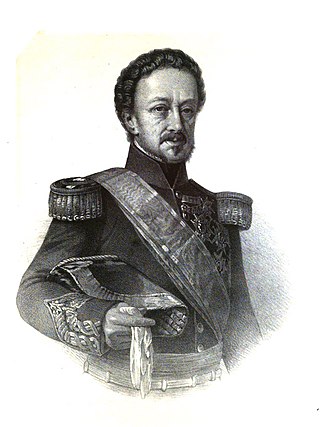
Pedro de Alcántara Téllez Girón y Alfonso-Pimentel, 2nd Prince of Anglona (1786–1851) was a Spanish military officer during the Peninsular War and a politician.

Marquess of Priego is a hereditary noble title of the Kingdom of Spain that Ferdinand the Catholic granted on 9 December 1501 to Pedro Fernández de Córdoba y Pacheco, 7th Lord of Aguilar in Córdoba, of the house of Córdoba. It is one of the most important noble titles in Spain, and was made a first class grandee in 1520 by Charles V, Holy Roman Emperor.